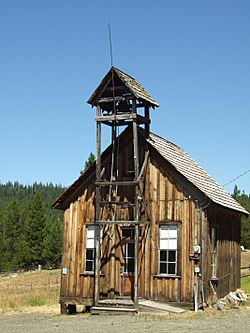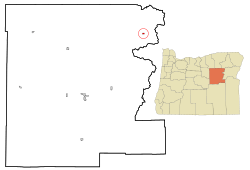Granite, Oregon facts for kids
Quick facts for kids
Granite, Oregon
|
|
|---|---|
 |
|

Location in Oregon
|
|
| Country | United States |
| State | Oregon |
| County | Grant |
| Incorporated | 1900 |
| Area | |
| • Total | 0.38 sq mi (0.98 km2) |
| • Land | 0.37 sq mi (0.96 km2) |
| • Water | 0.00 sq mi (0.01 km2) |
| Elevation | 4,672 ft (1,424 m) |
| Population
(2020)
|
|
| • Total | 32 |
| • Density | 86.02/sq mi (33.17/km2) |
| Time zone | UTC-8 (Pacific) |
| • Summer (DST) | UTC-7 (Pacific) |
| ZIP code |
97877
|
| Area code(s) | 458 and 541 |
| FIPS code | 41-30500 |
| GNIS feature ID | 2410642 |
Granite is a small city in Grant County, Oregon, in the United States. It is known for its history as a gold mining town. In 2010, only 38 people lived there, making it one of the smallest cities in Oregon. It was the fourth-smallest incorporated city in Oregon by population that year.
Contents
History of Granite
Early Days and Gold Discovery
Granite began as a mining camp after gold was found along Granite Creek on July 4, 1862. This area was first called Granite Creek Mines. A year later, a settlement named Granite City was started about 1.5 miles (2.4 km) downstream from where Granite is today.
Naming the Town
In 1867, the settlement moved to its current spot. It was renamed Independence because gold was first found on July 4. However, when the town's post office opened in 1878, it couldn't use the name Independence. Another city in Oregon already had that name. So, the name Granite was chosen instead. The post office closed in 1957, but the city kept the name. The creek itself got its name from the many granite rocks found in the area.
The Ah Hee Diggings, another important mining site, are located about one mile north of the town. In 1878, a miner and business owner named A. G. Tabor became Granite's first postmaster. Grant Thornburg became the first mayor when the city officially became a city (was incorporated) in 1900.
Economy
Gold Mining and World War II
Granite's economy depended heavily on gold mining for many years. But during World War II in 1942, the War Production Board in the United States issued an order called L-208. This order stopped all gold mining. The government believed gold mining was not important for the war effort. They wanted miners to focus on digging for "essential" metals needed for the war.
Because of this order, Granite's economy fell apart. After the war, telephone and electric services to Granite stopped. The city's population dropped sharply from 86 people in 1940 to only 2 people in 1960.
Life After the Mines
By 1990, Granite's population had slowly grown back to 10 people. In 2000, it reached 24, and telephone service was finally brought back to the city. As of 2002, Granite had two main businesses: The Outback, which sold food, fuel, and supplies, and The Lodge. As of September 2017, the population remained at 24, and both The Outback and The Lodge were still open.
Geography
Location and Landscape
Granite is located in the Blue Mountains in eastern Oregon. It is about 47 miles (76 km) west of Baker City by highway. It is also about 346 miles (557 km) east-southeast of Portland. The city covers a total area of about 0.37 square miles (0.96 km2), and all of it is land.
Elkhorn Drive Scenic Byway
The Elkhorn Drive Scenic Byway is a 106-mile (171 km) loop road. It mostly goes through forests in the Elkhorn Mountains. This scenic route passes right through Granite. Other towns along this beautiful drive include Baker City, Haines, and Sumpter. Sumpter is about 11 miles (18 km) southeast of Granite.
Who Lives in Granite?
Population Changes Over Time
Granite's population has changed a lot over the years, especially after the gold mines closed. Here's how the number of people living in Granite has changed:
| Historical population | |||
|---|---|---|---|
| Census | Pop. | %± | |
| 1870 | 448 | — | |
| 1880 | 200 | −55.4% | |
| 1890 | 249 | 24.5% | |
| 1900 | 245 | −1.6% | |
| 1910 | 89 | −63.7% | |
| 1920 | 55 | −38.2% | |
| 1930 | 45 | −18.2% | |
| 1940 | 86 | 91.1% | |
| 1950 | 40 | −53.5% | |
| 1960 | 3 | −92.5% | |
| 1970 | 4 | 33.3% | |
| 1980 | 17 | 325.0% | |
| 1990 | 8 | −52.9% | |
| 2000 | 24 | 200.0% | |
| 2010 | 38 | 58.3% | |
| 2020 | 32 | −15.8% | |
| source: | |||
A Look at the People (2010)
According to the census from 2010, there were 38 people living in Granite. These people made up 22 households and 13 families. The city had about 103 people per square mile (40 per km2). There were 88 housing units, meaning many buildings were available for people to live in.
Most of the people in Granite were White (about 95%). About 5% were Native American. About 5% of the population identified as Hispanic or Latino.
Out of the 22 households, only about 5% had children under 18 living with them. More than half (55%) were married couples living together. About 5% had a male head of the household without a wife present. About 41% of households were not families. Thirty-two percent of all households were made up of single individuals. About 9% had someone living alone who was 65 years old or older. The average household had about 1.7 people, and the average family had about 2 people.
The median age in Granite was 63 years old. This means half the people were older than 63, and half were younger. Only about 3% of residents were under 18. No one was between 18 and 24 years old. About 50% were between 45 and 64, and 45% were 65 years old or older. In terms of gender, about 58% of the population was male, and 42% was female.
See also
 In Spanish: Granite (Oregón) para niños
In Spanish: Granite (Oregón) para niños

